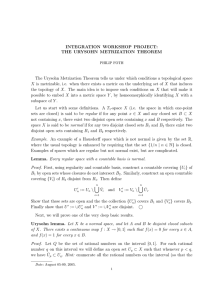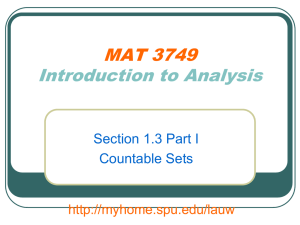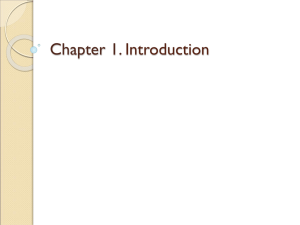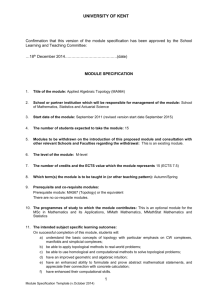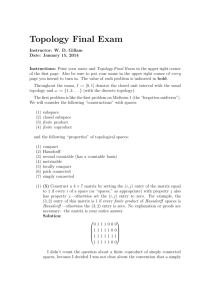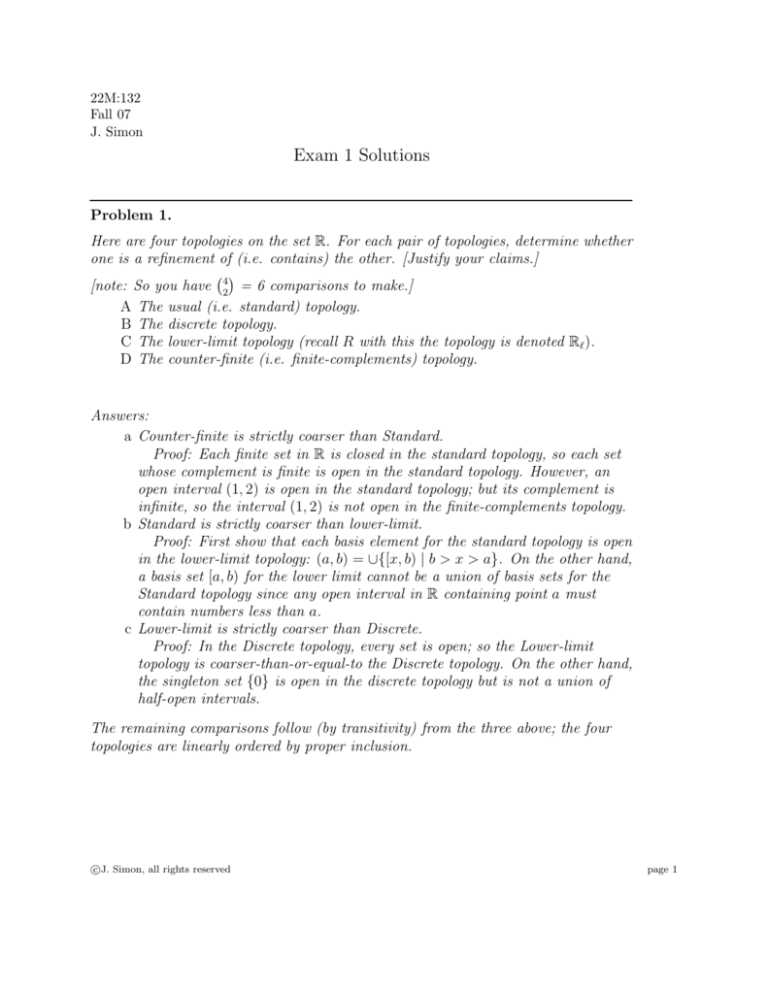
22M:132
Fall 07
J. Simon
Exam 1 Solutions
Problem 1.
Here are four topologies on the set R. For each pair of topologies, determine whether
one is a refinement of (i.e. contains) the other. [Justify your claims.]
[note: So you have 42 = 6 comparisons to make.]
A The usual (i.e. standard) topology.
B The discrete topology.
C The lower-limit topology (recall R with this the topology is denoted Rℓ ).
D The counter-finite (i.e. finite-complements) topology.
Answers:
a Counter-finite is strictly coarser than Standard.
Proof: Each finite set in R is closed in the standard topology, so each set
whose complement is finite is open in the standard topology. However, an
open interval (1, 2) is open in the standard topology; but its complement is
infinite, so the interval (1, 2) is not open in the finite-complements topology.
b Standard is strictly coarser than lower-limit.
Proof: First show that each basis element for the standard topology is open
in the lower-limit topology: (a, b) = ∪{[x, b) | b > x > a}. On the other hand,
a basis set [a, b) for the lower limit cannot be a union of basis sets for the
Standard topology since any open interval in R containing point a must
contain numbers less than a.
c Lower-limit is strictly coarser than Discrete.
Proof: In the Discrete topology, every set is open; so the Lower-limit
topology is coarser-than-or-equal-to the Discrete topology. On the other hand,
the singleton set {0} is open in the discrete topology but is not a union of
half-open intervals.
The remaining comparisons follow (by transitivity) from the three above; the four
topologies are linearly ordered by proper inclusion.
c Simon, all rights reserved
J.
page 1
Problem 2.
Let (X, T ) be a topological space, and let S be a sub-basis for T .
Prove: If S is countable, then there exists a countable basis for T .
Proof. The set of all finite intersections of elements of S is a basis B for T . We shall
define a countable set and a function from that countable set onto B; we have a
theorem that the image of a countable set is countable, so we will be able to
conclude that B is countable.
For each n ∈ Z+ , let Sn = (S × S × . . . × S) n times. A finite cartesian product of
countable sets is countable, so each Sn is countable. Let S = ∪∞
n=1 Sn . A countable
union of countable sets is countable, so S is countable.
Now define a surjective function φ : S → B by
φ(S1 , S2 , . . . Sk ) = S1 ∩ S2 ∩ . . . Sk .
Problem 3.
Let (X, T ) be a topological space, with A, B ⊆ X.
Prove:
A∪B =A∪B .
Proof. There are various ways to prove this; here is one.
We have the following theorems:
• The closure of a set is closed.
• The union of two closed sets is closed.
• The closure of a set is defined to be the intersection of all closed sets
containing the given set.
• and from the last statement above, if P ⊆ Q then P ⊆ Q.
So we can argue as follows:
A ⊆ A , and B ⊆ B =⇒ A ∪ B ⊆ A ∪ B .
Since A ∪ B ⊆ the closed set A ∪ B, the closure of A ∪ B must be contained in that
closed set; i.e.
A∪B ⊆A∪B .
Conversely,
A ⊆ A ∪ B =⇒ A ⊆ A ∪ B
and likewise for B.
c Simon, all rights reserved
J.
page 2
Problem 4.
Let {Xα }α∈J be a family of nonempty topological spaces; give Πα∈J Xα the product
topology.
Prove:
If Πα∈J Xα has the Hausdorff property, then each Xα has the Hausdorff property.
Proof. (For notational simplicity, we will write the product as if the index set is
assumed to be countable, Π Xn where n runs from 1 to some N or ∞.)
Fix an index k and show that the factor space Xk is Hausdorff. Let x, y be points in
Xk with x 6= y. Since the factor spaces are all nonempty [this is where we need that
hypothesis], in each space Xn (n 6= k) pick a point tn . Let x̂ ∈ Πn Xn be the point
that is x in coordinate k and tn in each other coordinate n. Similarly, let ŷ ∈ Πn Xn
be the point that is y in coordinate k and tn in each other coordinate n. Since the
product is Hausdorff, there exist disjoint open neighborhoods U(x̂) and V (ŷ). Since
we are using the product topology [this argument works equally well with the “box”
topology], inside U, V there are basic neighborhoods of x̂ and ŷ; since U, V are
disjoint, these subsets are disjoint. So we have disjoint product neighborhoods of
x̂, ŷ:
U ′ = U1 × U2 × . . . and V ′ = V1 × V2 × . . .
Note that x ∈ Uk and y ∈ Vk , and for each n 6= k, tn ∈ Un ∩ Vn . If there exists a
point zk ∈ Xk such that zk ∈ Uk ∩ Vk then we have a point in U ′ ∩ V ′ , namely let ẑ
be zk in coordinate k and tn in each coordinate n 6= k. Thus Uk and Vk are disjoint
neighborhoods of x, y in Xk .
We started with an arbitrary Xk and any two points of Xk and found disjoint
neighborhoods in Xk . Thus each Xk is Hausdorff.
Problem 5.
Let Y be an ordered set in the order topology. Let X be a topological space and let
f, g : X → Y be continuous functions.
a . Show that the set A = {x ∈ X | f (x) ≤ g(x) } is closed in X.
b . Let h : X → Y be the function
h(x) = min {f (x), g(x) } .
Show the function h is continuous.
[Hints: (a) Show X − A is open. (b) Use the ”pasting lemma”.]
c Simon, all rights reserved
J.
page 3
Proof. Let B = {x ∈ X | f (x) > g(x) }. We will show B is open.
All open intervals (a, b) and open rays (a, ∞), (−∞, b) are open sets in the order
topology on Y , and these sets form a basis; the rays form a sub-basis.
Let x be any point in B. We want to find a neighborhood of x contained in B. So
we need to find an open neighborhood U(x) such that for each w ∈ U, f (w) > g(w).
As in the proof that an order topology has the Hausdorff property, we claim there
exist disjoint sub-basic neighborhoods [i.e. open rays] U of f (x) and V of g(y). [If
there exists w ∈ (g(y), f (x)) then use (−∞, w) and (w, ∞). If the open interval
(g(y), f (x) is empty, then use the rays (−∞, f (x)) and (g(y), ∞).] Then
f −1 (U) ∩ g −1 (V ) is a neighborhood of x on which f is strictly larger than g.
For part (b), note that the function h is just f on the closed set A and g on the dual
closed set C where g(x) ≤ f (x). On the intersection A ∩ C, we have f (x) = g(x). So
by the “pasting lemma”, this function is well-defined and continuous.
Problem 6.
Suppose X, Y are topological spaces, and f : X → Y is a continuous function. In the
space X × Y (with the product topology) we define a subspace G called the
“graph of f ” as follows:
G = {(x, y) ∈ X × Y | y = f (x)} .
Prove: G is homeomorphic to X.
(Be sure to state clearly whatever theorem(s) you use in doing this proof.)
Proof. Define φ : X → G by φ(x) = (x, f (x)). As the cartesian product of two
continuous functions, φ is continuous. Check that φ iss a bijection [1-1 is because f
is a function; surjective is by definition of the “graph of f ”.] The function φ−1 is
just the restriction to G of the projection map πX : X × Y → X. We have a
previous theorem that πX is continuous and a theorem that the restriction of a
continuous function to a subspace is continuous. So φ−1 : G → X is continuous. c Simon, all rights reserved
J.
page 4

